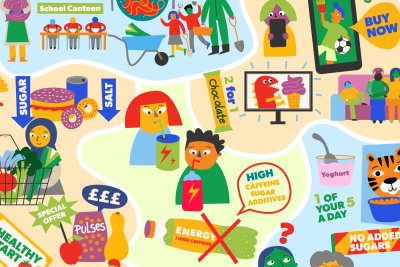News • Children's Food Campaign
Dodgiest junk food marketing claims of the year
Public vote Chupa Chups lollipops winners of the ‘Dodgiest Junk Food Marketing Claim’ of the Year
The makers of Chupa Chups lollipops were today declared convincing winners of the ‘Dodgiest Junk Food Claim’ of 2011, receiving more than twice the number of votes than other misleading claims in a poll commissioned by the Children’s Food Campaign. [1] The company won the dubious acclaim for an animation on its website which implies that its yellow lollipops are produced from lemon juice, when in reality they contain only 3% fruit. People were asked to vote [2] on which of five of the most dodgy junk food claims nominated by the Children’s Food Campaign was the most misleading, producing the following ranking:
|
Position |
Company |
Misleading claim |
|
Winner |
Perfetti Van Melle |
Implying in an animated video on its Chupa Chups website that its yellow lollipops were made from only real lemon juice, when they only contain 3% fruit. [3] |
|
Runner up |
British Soft Drinks Association |
Claiming on educational materials for children, “Variations in climate and reduced sunshine levels can affect the crop, so small quantities of sugar may need to be added to achieve desired sweetness.” Many sweet drinks contain very large amounts of sugar, which is nothing to do with climate. [4] |
|
3rd place |
Britvic |
Claiming on an educational ‘learning zone’ website for children, “Dentists believe insufficient saliva, a side effect of not drinking enough, may be a major cause of tooth decay”, with no mention that soft drinks often also contain sugar and are also often acidic, which are major causes of dental decay and erosion. [5] |
|
4th place |
Coca-Cola |
Claiming under the brands section of its website, “Spring waters with fruit juice, and enriched with minerals and vitamins”, when only 3 out of 8 of the products in this range contain any form of fruit (and of the 3 that do, it is in the form of fruit concentrate). [6] |
|
5th place |
Ferrero UK |
Stating in a TV advert for Nutella which targets families that “Each 15g portion contains two whole hazelnuts, some skimmed milk, and cocoa”, but not telling parents that the product also contains high amounts of sugar. [7] |
The Children’s Food Campaign has complained to the Advertising Standards Authority (ASA) about the four most misleading claims, made by Chupa Chups, British Soft Drinks Association and Britvic to the Advertising Standards Authority (ASA). [8] The fifth ranked misleading claim, by Nutella, was subject to an ASA complaint in August this year. [9]
Kawther Hashem of the Children’s Food Campaign commented:
“It is unforgivable that junk food companies not only relentlessly target children, but also often shamelessly mislead the public with half-truths and made up so-called facts”.
She went on to say:
“If ever there was a time to regulate an industry out of control, it is the junk food industry and now – we call upon the Government to live up to its responsibility to protect children and the wider public. We want to see consistent advertising regulations and vigorous enforcement across all forms of media.”
The survey comes in the same month that the Children’s Food Campaign and the British Heart Foundation published a report exposing how junk food companies target children with their online marketing for foods high in fat, salt or sugar. [10]
For further information and interviews, please contact Charlie Powell or Kawther Hashem on tel: 0203 5596 777 or email: charlie@sustainweb.org / kawther@sustainweb.org
Notes to editors:
1. The Children's Food Campaign wants to improve children's health and well-being through better food - and food teaching - in schools, and protecting children from junk food marketing. We are supported by over 150 national organisations. The Children's Food Campaign is coordinated by Sustain: the alliance for better food and farming and funded by the British Heart Foundation. See: http://www.childrensfoodcampaign.org.uk
2. The poll was carried out on 16th December 2011 and was answered by 1,000 people using Toluna Survey. Toluna QuickSurveys is an online tool that helps people create and launch surveys. The survey tool plugs into Toluna.com, which states that it is one of the largest online survey communities in the world with more than 4 million members in 34 countries. The Children’s Food Campaign survey was focused on consumers in the UK.
3. The Chupa Chups animation can be viewed at: http://www.chupachups.co.uk/. The animation received 390 votes. Chupa Chups contains only 3% juice. Ingredients: Sugar, glucose syrup, whey powder, food acid citric, concentrated fruit puree (equivalent to fresh fruits 3% apple, cherry, raspberry, pineapple, lime, lemon, strawberry, peach, flavourings, colours E162 E100, malt extract.
4. The Soft drinks manufacturers association’s educational materials for children, are available on the British Soft Drinks Association website and can be viewed at: http://www.liquidsmeanlife.org.uk/member/KS3&4%20new%20material/Pupils%20notes/Fruit%20Juices.pdf . This claim received 180 votes in the survey.
According to the FSA Traffic Lights Labelling scheme, all the following are examples of soft drinks which would receive a red light, indicating high sugar content:
Coca Cola Cherry contains 11.2g sugar per 100g
Capri-Sun Orange Juice Drink contains 10.9g sugar per 100g
Ribena Original blackcurrant contains 10.5g sugar per 100g
Princes 100% Pure Orange Juice from Concentrate contains 9.1g sugar per 100g
5. The claim was found on the Britvic ‘learning zone’ website and can be viewed at: http://www.britviclearningzone.com/consumers_and_health/soft_drinks_health/health_benefits.php This claim received 161 votes in the survey. According to the British Dental Association, “Ideally, you should give your children milk or water wherever possible and avoid sugary or fizzy drinks. Fruit squashes are usually full of sugar which can cause tooth decay, while fizzy drinks and fruit juices contain acid which can wear away the enamel”, see: http://www.bdasmile.org/infants/infants.cfm?contentid=1364&contentparentid=1028.
6. The claim was found on the Coca Cola website under the brands section and can be viewed at: http://www.coca-cola.co.uk/brands/glaceau.html . This claim received 142 votes on the survey.
7. The Nutella commercial is available on the Nutella website, can be viewed at: http://www.wakeuptonutella.co.uk/TV_Ad.php . The Voiceover states, “More and more families are discovering Nutella. Each 15 g portion contains two whole hazelnuts, some skimmed milk, and cocoa. And Nutella releases its energy slowly. Wake up to Nutella.” However, the main ingredients in Nutella are sugar (31.1g per 100g) and vegetable oil. The advert received 127 votes in the survey.
8. The Advertising Standards Authority (ASA) is an advertising industry body set up to apply voluntary codes of practice and avoid regulation. Our complaints highlight breaches of clauses in Section 1 on Compliance and Section 3 on Misleading Advertising of the Committee of Advertising Practice’s Code.
9. The Children’s Food Campaign, members of the public and other organisations complained to the ASA about the Nutella commercial in August 2011. In spite of noting in its adjudication that, “Nutella contained sugar and fat as well as hazelnuts, skimmed milk and cocoa” and that “Nutella had a high sugar and fat content and that such foods should be eaten in moderation”, the ASA chose not uphold these complaints (see: http://www.asa.org.uk/ASA-action/Adjudications/2011/6/Ferrero-UK-Ltd/TF_ADJ_50891.aspx). The Children’s Food Campaign’s criticism of this industry-biased response can be found at:https://www.sustainweb.org/news/nutella_asa_condemnation/
10. The report – The 21st century gingerbread house: How companies are marketing junk food to children online – exposes how junk food manufacturers bombard kids with online marketing to entice them to eat more unhealthy products. The brands featured in the report are products high in fat, salt or sugar (HFSS) and are promoted by companies online to get round regulations which prevent them advertising HFSS products during children’s television programmes. See: https://www.sustainweb.org/news/dec11_manufacturers_prey_on_children_online/
Published Friday 30 December 2011
Children's Food Campaign: Better food and food teaching for children in schools, and protection of children from junk food marketing are the aims of Sustain's high-profile Children's Food Campaign. We also want clear food labelling that can be understood by everyone, including children.




